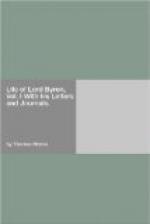[Footnote 93: Thus addressed always by Lord Byron, but without any right to the distinction.]
[Footnote 94: The Journal entitled by himself “Detached Thoughts.”]
[Footnote 95: Few philosophers, however, have been so indulgent to the pride of birth as Rousseau.—“S’il est un orgueil pardonnable (he says) apres celui qui se tire du merite personnel, c’est celui qui se tire de la naissance.”—Confess.]
[Footnote 96: This gentleman, who took orders in the year 1814, is the author of a spirited translation of Juvenal, and of other works of distinguished merit. He was long in correspondence with Lord Byron, and to him I am indebted for some interesting letters of his noble friend, which will be given in the course of the following pages.]
[Footnote 97: He had also, at one time, as appears from an anecdote preserved by Spence, some thoughts of burying this dog in his garden, and placing a monument over him, with the inscription, “Oh, rare Bounce!”
In speaking of the members of Rousseau’s domestic establishment, Hume says, “She (Therese) governs him as absolutely as a nurse does a child. In her absence, his dog has acquired that ascendant. His affection for that creature is beyond all expression or conception.”—Private Correspondence. See an instance which he gives of this dog’s influence over the philosopher, p. 143.
In Burns’s elegy on the death of his favourite Mailie, we find the friendship even of a sheep set on a level with that of man:—
“Wi’ kindly bleat,
when she did spy him,
She ran wi’ speed:
A friend mair faithful ne’er came nigh him,
Than Mailie dead.”
In speaking of the favourite dogs of great poets, we must not forget Cowper’s little spaniel “Beau;” nor will posterity fail to add to the list the name of Sir Walter Scott’s “Maida.”]
[Footnote 98: In the epitaph, as first printed in his friend’s Miscellany, this line runs thus:—
“I knew but one unchanged—and here he lies.” ]
[Footnote 99: We are told that Wieland used to have his works printed thus for the purpose of correction, and said that he found great advantage in it. The practice is, it appears, not unusual in Germany.]
[Footnote 100: See his lines on Major Howard, the son of Lord Carlisle, who was killed at Waterloo:—
“Their praise is hymn’d
by loftier harps than mine;
Yet one I would select from
that proud throng,
Partly because they blend
me with his line,
And partly that I did his
sire some wrong.”
CHILDE HAROLD, CANTO III.]
[Footnote 101: In the fifth edition of the Satire (suppressed by him in 1812) he again changed his mind respecting this gentleman, and altered the line to
“I leave topography to rapid Gell;”
explaining his reasons for the change in the following note:—“‘Rapid,’ indeed;—he topographised and typographised King Priam’s dominions in three days. I called him ‘classic’ before I saw the Troad, but since have learned better than to tack to his name what don’t belong to it.”




